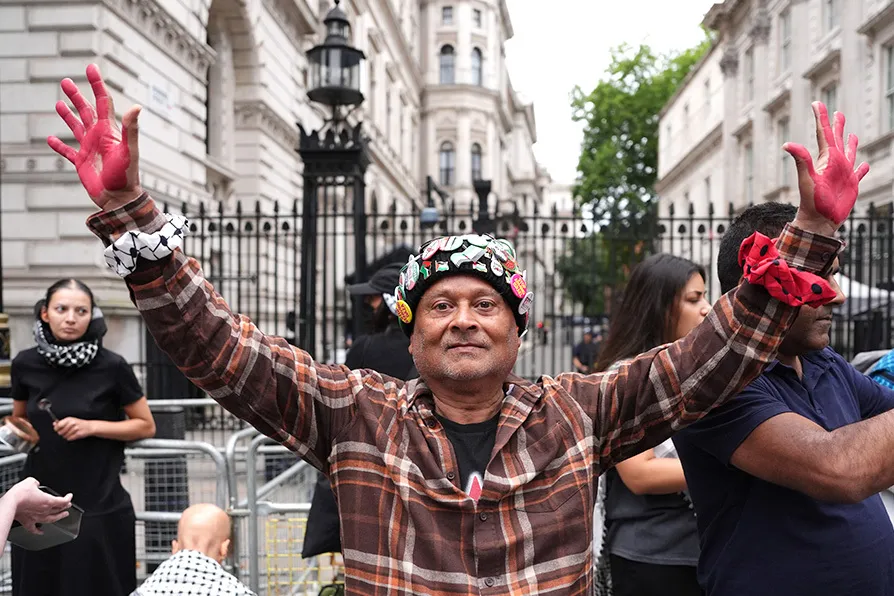JENNY MITCHELL, poetry co-editor for the Morning Star, introduces her priorities, and her first selection
MIKE COWLEY relishes an exhibition that reminds us, in the teeth of establishment pushback, that lasting change always begins in workplaces, communities and the street

 A protester outside Downing Street in London, July 29, as Keir Starmer recalled his cabinet to discuss Gaza and faces renewed pressure to recognise Palestine as a state immediately
A protester outside Downing Street in London, July 29, as Keir Starmer recalled his cabinet to discuss Gaza and faces renewed pressure to recognise Palestine as a state immediately
THE Frankfurt School’s Theodor Adorno wasn’t the most optimistic of Marxists. But his gloomy insights into a “culture industry” increasingly adept at inoculating capital against mass working-class rebellion were prescient.
For Adorno, capitalism sells us the things we do not need by sugaring the hard sell with subtle references to the things we as human beings yearn for — community, connectivity and freedom.
We are all, according to Yannis Varoufakis, “cloud serfs” to the new techno-feudalists, providing free content (unpaid labour) to the new masters of the online universe.
The tyranny of algorithms offer the illusion of agency and convenience while trapping us in ideologically freighted feedback loops and echo chambers. If Marx could see just how sophisticated the fetishising of commodities has become, he might reluctantly acknowledge capitalism’s endless capacity to safeguard itself from scrutiny.
With Reform preparing its latest electoral advances at next year’s English local elections and the Scottish general election, Adorno’s claim that there are “proto fascists (authoritarian personalities ripe for moulding in the image of far-right demagogues) everywhere” feels worryingly apposite.
Against this landscape, Steve McQueen’s Resistance exhibition at Edinburgh’s National Galleries is a welcome attempt to reclaim British history as shaped by street protest and dissent. While our more courageous politicians have sometimes legislated for social progress in the teeth of Establishment pushback, McQueen’s a photographic history reminds us that lasting change always begins in workplaces, communities and the street.
![Demonstration against the imminent invasion of Iraq, 15 February 2003 [Pic: Andrew Wiard]](/sites/default/files/styles/large/public/2025-08/Andrew%20Wiard%2C%20Demonstration%20against%20the%20imminent%20invasion%20of%20Iraq%2C%2015%20February%202003%20_1.JPG.webp?itok=gpAOwer8)
The kinetic energy of people seeking to forge new realities from grassroots struggle is vividly brought to life. In each period and no matter the odds, the creativity and determination of uprisings against exploitative employers, hostile governments and the fascist far-right prevail.
It would be a disservice to describe these photographs as “stills.” They encase an irrepressible humanity that animates the faces of marchers, pickets, speakers and organisers. There is a joy in crossing a psychological Rubicon. A spirit of elated defiance illuminates every photo: Sylvia Pankhurst recovering from a hunger strike in 1913. Annie Kenney, an Oldham cotton factory worker, smiling widely into the camera as she is detained by police.
![Unknown photographer, Annie Kenney (an Oldham cotton mill worker) arrested in London, April 1913 [Pic: © Alamy]](/sites/default/files/styles/large/public/2025-08/Unknown%20photographer%2C%20Annie%20Kenney%20%28an%20Oldham%20cotton%20mill%20worker%29%20arrested%20in%20London%2C%20April%201913%20%C2%A9%20Alamy_1.jpg.webp?itok=_6DDSMQF)
Mass protests at the racist attack at New Cross, a solidarity rally with the Soweto Uprising in Notting Hill and the Free Pollok eco-camp attest to a bloody-minded insistence on public dignity, rights and space. Running parallel to this history of rebellion, the agents of the state — the military and the police — are a ubiquitous presence.
Yvette Cooper’s clampdown on the right to protest places her firmly on the wrong side of the stories told here. In contrast, Keir Hardie saw parliament as a means to an end. Its corridors threatened to imprison the most dedicated reformer.
Hardie understood that elected socialists must keep parliament’s ossified rituals at arm’s length. The suspension of Brian Leishman MP for opposing the government’s attacks on the disabled, and for speaking out in support of the Grangemouth and Alloa communities he represents, exposes a Labour leadership aggrieved at those who speak with conviction and purpose.
But Brian would be the first to point out that though effective campaigns entail eloquent and charismatic champions to amplify their demands, in the absence of mass movements, even the best MPs can be left vulnerable to attack. “Instinctively,” Hardie said, “we are all communists at heart.” Resistance captures the eternal truth of his observation.
Exploitation, class hierarchies and the suffering of the many at the hands of a few have always been countered by a vision of a different and better world. A long procession of iron heels have weighed on the necks of the poor. But with equal and sometimes greater force, campaigns uniting diverse communities in common cause have just as predictably combined to rise up and throw off their chains.
In an unwitting echo of Adorno’s suspicions, the “grown-ups” in charge of Labour see conservatism everywhere. Their politics are shaped by a dreary defeatism, leading them to dismiss progressive mobilisations as indulgent denials of the natural order of things, the “politics of protest”. But as Resistance shows, a stubborn resolve runs through the British psyche like Blackpool through a stick of rock. This wonderful, restorative exhibition provides vital witness to those efforts. It is an invitation to add our own chapters to those struggles.
Resistance runs until January 4 2026 at National Galleries Scotland, Edinburgh. For more information see: nationalgalleries.org https://www.nationalgalleries.org/exhibition/resistance










